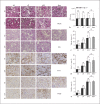A Novel Standardized Method of Renal Biopsy in Mice
- PMID: 34395545
- PMCID: PMC8314767
- DOI: 10.1159/000513354
A Novel Standardized Method of Renal Biopsy in Mice
Abstract
Introduction: In animal models, it can be difficult to confirm therapeutic effects due to technical inconsistencies and other reasons. Although renal biopsy is widely used in clinical diagnosis, it is rarely used in animal experimental models, especially in mice, because the problems of surgery-induced renal injury and bleeding have not been solved.
Methods: We developed an easy-to-use method of renal biopsy in mice and evaluated whether 3 consecutive renal biopsies can be performed in the same kidney in a standardized manner. This method was verified using 2 mouse models, a healthy mouse model and a unilateral ureteral obstruction (UUO) mouse model, and evaluated based on renal function and histological changes.
Results: There were no perioperative complications in any of the model mice. There was no significant difference in serum Cr, 24-h urine protein, or kidney/body weight ratio between the biopsy and control groups. Each biopsy sample contained sufficient renal tissue. The damage to the operated tissue was limited to the tissue near the biopsy site. Compared with renal tissues in the corresponding control group, the renal tissues obtained from the 3 biopsies (healthy model days 0, 4, and 7 and UUO model days 3, 7, and 10) and the remnant renal tissues after the biopsy showed no significant difference in the glomerular sclerosis index, degree of renal tubular damage, inflammatory response and renal fibrosis in these 2 models.
Conclusions: Our new standardized method of renal biopsy in mice is a safe and cost-saving approach that allows repeated renal biopsies and ensures minimal trauma and sufficient sample size to quality in experimental disease models.
Keywords: New standardized method; Renal biopsy.
Copyright © 2021 by S. Karger AG, Basel.
Conflict of interest statement
The authors have no conflicts of interest to declare.
Figures




References
-
- Rooney N, Mason SM, McDonald L, Däbritz JHM, Campbell KJ, Hedley A, et al. RUNX1 is a driver of renal cell carcinoma correlating with clinical outcome. Cancer Res. 2020 Jun 1;80((11)):2325–39. - PubMed
-
- Shimizu A, Masuda Y, Mori T, Kitamura H, Ishizaki M, Sugisaki Y, et al. Vascular endothelial growth factor165 resolves glomerular inflammation and accelerates glomerular capillary repair in rat anti-glomerular basement membrane glomerulonephritis. J Am Soc Nephrol. 2004 Oct;15((10)):2655–65. - PubMed
-
- Gong B, Gou X, Han T, Qi Y, Ji X, Bai J. Protective effects of rutin on kidney in type 1 diabetic mice. Pak J Pharm Sci. 2020 Mar;33((2)):597–603. - PubMed
LinkOut - more resources
Full Text Sources

